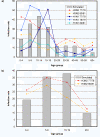Reconstructing the 2003/2004 H3N2 influenza epidemic in Switzerland with a spatially explicit, individual-based model
- PMID: 21554680
- PMCID: PMC3112096
- DOI: 10.1186/1471-2334-11-115
Reconstructing the 2003/2004 H3N2 influenza epidemic in Switzerland with a spatially explicit, individual-based model
Abstract
world has not faced a severe pandemic for decades, except the rather mild H1N1 one in 2009, pandemic influenza models are inherently hypothetical and validation is, thus, difficult. We aim at reconstructing a recent seasonal influenza epidemic that occurred in Switzerland and deem this to be a promising validation strategy for models of influenza spread.
Methods: We present a spatially explicit, individual-based simulation model of influenza spread. The simulation model bases upon (i) simulated human travel data, (ii) data on human contact patterns and (iii) empirical knowledge on the epidemiology of influenza. For model validation we compare the simulation outcomes with empirical knowledge regarding (i) the shape of the epidemic curve, overall infection rate and reproduction number, (ii) age-dependent infection rates and time of infection, (iii) spatial patterns.
Results: The simulation model is capable of reproducing the shape of the 2003/2004 H3N2 epidemic curve of Switzerland and generates an overall infection rate (14.9 percent) and reproduction numbers (between 1.2 and 1.3), which are realistic for seasonal influenza epidemics. Age and spatial patterns observed in empirical data are also reflected by the model: Highest infection rates are in children between 5 and 14 and the disease spreads along the main transport axes from west to east.
Conclusions: We show that finding evidence for the validity of simulation models of influenza spread by challenging them with seasonal influenza outbreak data is possible and promising. Simulation models for pandemic spread gain more credibility if they are able to reproduce seasonal influenza outbreaks. For more robust modelling of seasonal influenza, serological data complementing sentinel information would be beneficial.
Figures






References
-
- Bonmarin I, Levy-Bruhl D. Apport des modélisations des épidémies dans la décision de santé publique: exemple de la pandémie grippale. Méd Mal Infect. 2007;37:S204–S209. - PubMed
-
- Eynard F, Koch D, Birrer A, Boubaker K, Matter HC, Raeber PA, Influenza Working Group (AGI) In: Swiss influenza pandemic plan: Strategies and measures in preparation for an influenza pandemic. Bern, CH, editor. Bundesamt für Gesundheit (BAG); 2009. January 2009.
Publication types
MeSH terms
LinkOut - more resources
Full Text Sources
Medical

